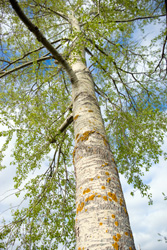Poplar trees make wood and reduce carbon levels
Since the Kyoto protocol of 1997, goals have been set for the reduction of carbon dioxide emissions. As these targets are necessarily long-term, one solution to buy time is to use the principle of carbon sequestration. This uses natural or artificial carbon sinks as a reservoir. Planting forests is one obvious solution as rapidly growing vegetation absorbs carbon dioxide (CO2) and holds it in leaf carbohydrates. FACE (Free Air CO2 Enrichment) technology has been developed to test this premise. Disappointingly, a recent study of mature forests indicated that there is no increase in carbon retention when CO2 levels are elevated. Under certain circumstances, increased uptake of CO2 supplied at higher concentrations can be offset naturally by the plant's physiology. This so-called process of acclimation whereby the tree adapts and down-regulates photosynthetic activity is a threat to the success of the initiative. However, EUROFACE project partners at the University of Essex investigated fast growing poplar stands for their ability to remove excess CO2 under a FACE regime. The scientists found that following coppice, or felling of a small section of the plantation, net photosynthesis rate was no more than at ambient CO2 levels. It seemed then that careful management was necessary to avoid this lowered CO2 uptake. However the team then found that the young poplar tree displays physiological features that can compensate for this. A factor not considered in previous studies was that poplar trees of a certain variety were shown to be photosynthetically competent earlier at elevated CO2 levels. Overall, they found that poplar trees were able to escape long-term acclimation by a high starch synthesis and carbon export rate. As an added bonus, poplars can be used for rapid wood production. Provided poplar trees are grown with adequate water and nutrients, the photosynthetic carbon gain is proportional to the wood produced. The poplar therefore can be used as a carbon sink with the added benefit of producing timber crops.







